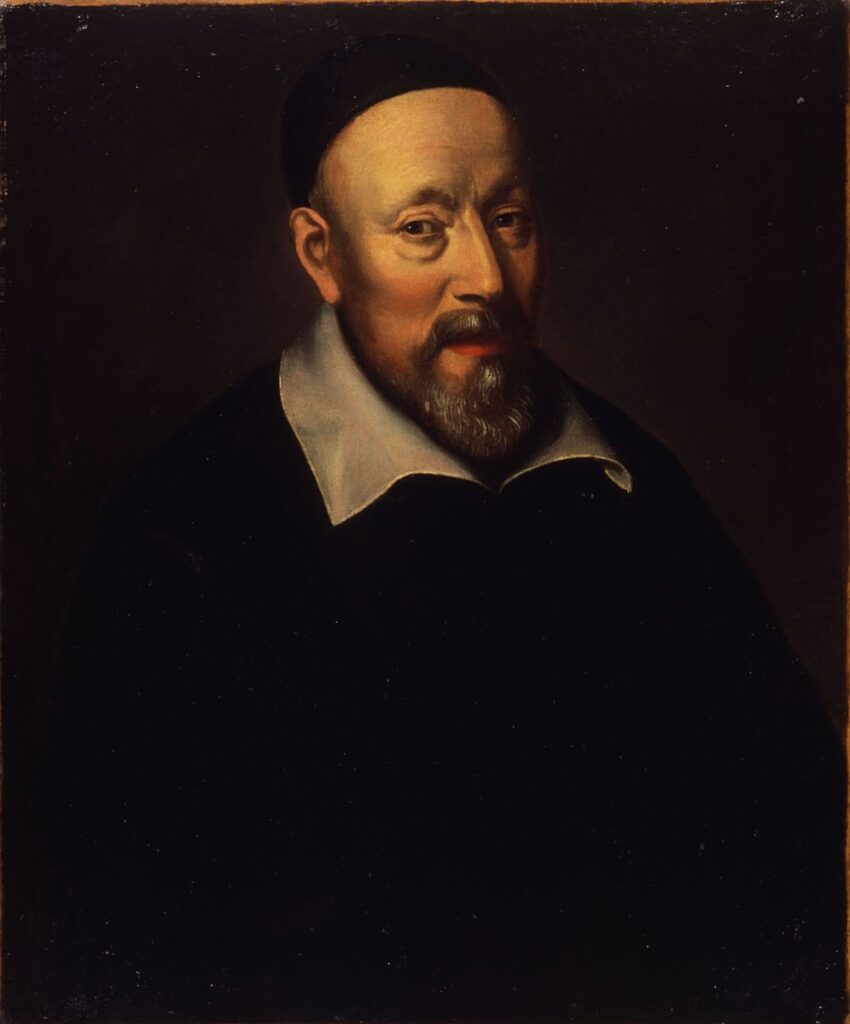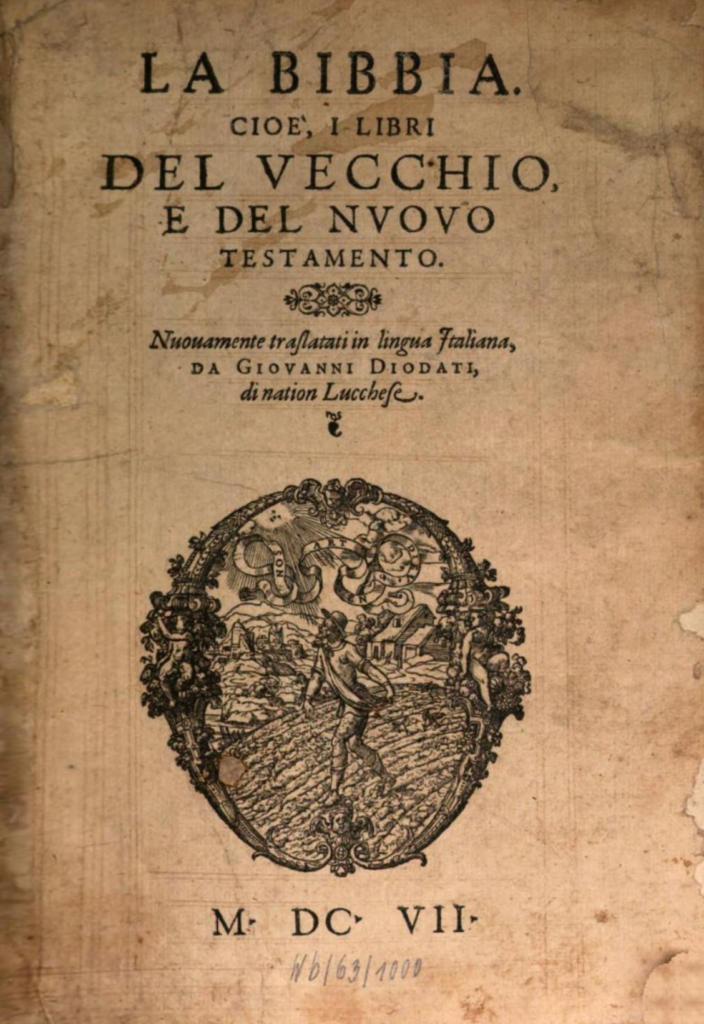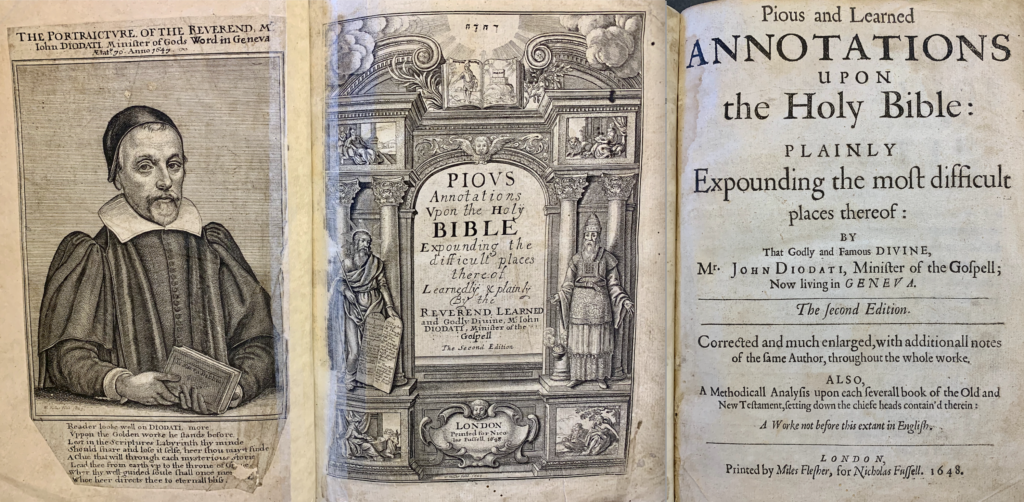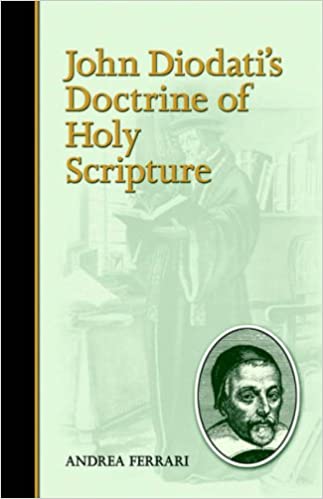
Giovanni Diodati (1576-1649) may be the most important reformer you’ve never heard of. At least that was the case with me until several weeks ago when I was preparing for a Zoom seminar with believers in Italy on how to study the Bible. I soon learned of the importance of Diodati’s translation of the Bible into Italian. In fact, Diodati’s entire life and ministry exemplified Sola Scrittura, the basic protestant thesis that the Bible is our sole authority for faith and practice.
Diodati was born in Switzerland on June 6, 1576, into a wealthy family from Lucca, Tuscany. Along with many other families with protestant leanings due to the ministry of Pietro Martire Vermigli, the Diodatis had emigrated to Geneva because they were no longer welcome in their homeland. Giovanni graduated from the Geneva Academy in 1596. A prodigy in biblical languages, he was soon recommended by Theodore Beza to join the faculty as professor of Hebrew. He went on to become professor of Theology in 1606 and in 1608 became a parish minister in Geneva. Missions to Italy in 1608 and to France in 1614 were opposed by Roman Catholic authorities and did not achieve any major success for the reformation.
As a parish minister with academic gifts, Diodati continued to labor in teaching, preaching, Bible translation, and writing. He represented Geneva at the Synod of Dordt in 1618-19 and was one of the six people appointed to write the Canons of Dort. Ill-health plagued Diodati from around this time. His 1621 translation of Paolo Sarpi’s History of the Council of Trent into French was well received, but the struggle over the publication (1644) and distribution of his translation of the Bible into French led to him being viewed as a bitter man. Diodati continued as a professor in Geneva until 1645 and died on October 3, 1649. Some say his career was more successful at its outset than at its end, but this fails to consider the impact of his translation of the Bible into Italian and the translation of his Pious and Learned Annotations into English. Although he did not live in Italy, the theologian ‘di nation Lucchese’ could hardly have made a more notable contribution to Italian Protestantism and to Italian literature. (William McComish, p. 5 of the work cited below)
• • • • • • •
CORSO DI FORMAZIONE INTENSIVA: COMO INTERPRETARE LA BIBBIA
In early October I led a seminar on how to interpret the Bible for La Chiesa Evangelica Veritas in Rozzano, Italy. This 20 hour bilingual seminar (in English with Italian translation) contains 12 lectures along with question and answer sessions. For the seminar video, go here. Audio is available here, an English study guide here, and an Italian Study Guide translated by Deborah Jones here.
• • • • • • •

Diodati’s Translation of the Bible

with his 1648 annotation on the verse (right)
Diodati was adept in Hebrew and Greek. His translation of the Bible into Italian was the very first one drawn directly from the original languages—earlier translations were based on the Latin Vulgate. Diodati hoped that this translation as well as his French translation would trigger the reformation in Italy and France but this did not happen, at least on any large scale.
It is remarkable that Diodati’s translation first appeared in 1603 (some sources have 1607) when he was only 27 years old, and that he accomplished it with little assistance from others. By contrast the King James Version appeared in 1611 as the work of six groups of translators, 47 in all. The Diodati translation has been valued not only for its accuracy but also for its readability. It contains introductory notes, with additional cross references and notes in the margins, much like reference Bibles today. Through the years Diodati expanded these notes so that the meaning of the Bible would be as clear as possible to as many Italians as possible. Like the KJV in English, this Italian translation has been in print for over 400 years.

of Diodati’s 1648 Pious and Learned Annotations upon the Holy Bible
Diodati’s Annotations
Diodati first published his Annotiationes in Biblia in Latin in 1607. Subsequent editions were enlarged, and the work was eventually translated into English and published in 1643. The second English edition (1648) is pictured above. I was blessed with the opportunity to peruse this volume recently at the William Perkins Library of Puritan Reformed Theological Seminary in Grand Rapids. I found the terse annotations (see a sample on 2 Tim 2:15 above) to be philologically sophisticated, yet clearly expressed and useful for lay and clergy readers alike. I saw more of the author’s piety than his theology. I was surprised to find a meticulous and helpful analysis of the flow of thought of each biblical book. These analyses utilize brackets to break down the text and display it in increasingly smaller units of thought. This approach was evidently innovative, leading to the blurb on the title page:
A Methodicall Analysis upon each severall book of the Old and New Testament, setting down the chiefe heads contain'd therein: A Worke not before this extant in English.
Diodati’s Annotations engage the Bible by analyzing its individual words and synthesizing the literary context of those words. This approach is consistent with the approach Calvin lauded in the preface to his Romans Commentary—the quest for clear brevity in expounding the mind of the author. This approach is also consistent with the more recent emphasis in hermeneutics on the quest for valid meaning as an interplay between the parts and the whole. Diodati did not miss the forest for the trees.
Diodati’s Legacy
Let the elders who rule well be considered worthy of double honor, especially those who labor in preaching and teaching (1 Tim 5:17 ESV). Although beset by health problems and seeming failures for the last 30 years of his life, Giovanni Diodati continued his faithful labors in the Word until the end. His teaching career began when he was only 20 years old. His Annotationes, first published in 1607 when he was 31 years old. later, were revised, translated into English, and republished a year before his death at the age of 63. His translation of the Bible into Italian was first issued in 1607 (the King James Version English Bible was first published in 1611) when he was only 27, and he was still working on the translation 38 years later in 1641 when it was published with more complete notes and a metrical psalter. The Diodati Bible has been revised six times over the last four centuries, leading to the publication of La Nuova Diodati in 1991. This Bible is widely used today by Italian protestants. Another Bible that is popular with Italian protestants, the Riveduta, began in 1924 as a revision of Diodati based on more ancient Greek manuscripts. La Nuova Riveduta (2006) is also available with helps and study notes supplied by Pastor John McArthur.
Diodati may indeed be the most important reformer we’ve never heard of, especially when Sola Scrittura is viewed as the basis of all the other Solas of the reformation. When we consider his good works today, 371 years to the month after his death, may we glorify our Father in heaven.
Remember your leaders who taught you the Word of God. Think of all the good that has come from their lives, and follow the example of their faith. (Heb 13:7 NIV)
For Further Study
Although one finds occasional references to Diodati’s work in specialized scholarship, there is apparently no definitive treatment of his life or analysis of his work. The small book by Maria Betts, Life of Giovanni Diodati, Genevese Theologian, Translator of the Italian Bible (London: Thynne, 1905) is a translation and abridgement of Vie de Jean Diodati, Theologien Genovois by E. de Budé (Lausanne, 1869).

The best introduction to Diodati’s life and work is probably Andrea Ferrari’s John Diodati’s Doctrine of Holy Scripture (Grand Rapids: Reformation Heritage, 2006). Ferrari surveys the background Diodati’s life and provides a biography. He develops Diodati’s doctrine of Scripture from his 1596 graduation thesis on that topic for the Geneva Academy. Ferrari also probes The Pious and Learned Annotations to discern Diodati’s mature thought on the doctrine of Scripture.

Another book dealing in depth with Diodati is William A. McComish’s The Epigones: A Study of the Theology of the Genevan Academy at the Time of the Synod of Dort, with Special Reference to Giovanni Diodati (Eugene: Pickwick, 1989). McComish provides a biographical sketch of Diodati and an extensive bibliography of Diodati’s writings.
David
Fascinating individual who I had never heard about until now.
Thank you for informing me of this important man!
Enjoyed this post, David! Thank you for illuminating the man, Diodati, and his work from a dark and obscure past.
Very interesting
Thank you so much for the wonderful write-up. My study is so limited that I never came across Diodati.
If I may, I would just like to make a few corrections. Diodati never printed his annotations separate from the Bible. Some reference his annotations in his 1607 Italian Bible in Latin, which has caused some confusion. His first edition was not published in 1603, but was presented to the Pastors of Geneva for approval in 1603. They recommended changes and it wasn’t printed until 1607. Diodati’s was not the first edition of the Italian Bible to use Hebrew and Greek as the base. Antonio Brucioli did it first followed by other revision of his. Diodati used the 1562 Rustici Bible as his base, but even Diodati said he followed Jerome where he could. Lastly there have been more than 4 revisions of Diodati’s Bible since 1607. It is hard to say how many, because some are so minor. The 1898 edition changed Hebrews 10:12, but I don’t think it changed much more than that. In 1885 Psalms 16:2 was changed. The 1857 finally caught a printing error in 2 Corinthians 4:18 and changed 2 Corinthians 2:3 where Diodati followed more of a Vulgate/Complutensian reading. In 1859 1 Peter 4:15 was changed. Then there was the Giucciardino edition of 1855, the Ferretti edition of 1853/54, as well as an edition edited with Luzzi’s help in 1894 and others. The Nuova Diodati is not really based on Diodati as much as it is based on the Riveduta. For example Diodati never used Eterno, but the Riveduta did. Just start reading through them and you can easily see that the Riveduta was the base of the Nuova Diodati with changes made more towards the CEI and Diodati.
Christopher, thanks for these comments on my summary of Diodati’s work. I’ve found both 1603 and 1607 as publication dates of the translation; your comments clarify that discrepancy. I think I mentioned that the translation has undergone six revisions. I’m sure, as you said, many relatively minor revisions have been made through the years. As to the Nuova Diodati being conformed to the Riveduta, I suppose that situation may parallel that of the English NKJV being similar to other formal equivalent translations such as the NASB and ESV. There are still differences when it comes to the preferred manuscript tradition. I see the Nuova Diodati still includes Textus Receptus readings in texts like Mark 16:9-20, John 7:53-8:11, Acts 8:l37, and 1 John 5:7. The Riveduta does not include these as biblical text.
I’m not clear on your comments about the Annotations not being published apart from the Bible translation. My perusal of the Annotations shows that it is written much like many verse-by-verse commentaries today, with key words extracted from the verses followed by the annotations. But I was looking at the English translation of the Annotations; perhaps you are referring to earlier notes added to the original Italian translation.
You might be interested in my second post on the Bible in Italy- http://drdavidlturner.com/2020/12/la-bibbia-e-litalia-semper-reformata/. I refer to other Italian translations, including Brucioli’s, in that post. Thanks again for your interest and comments!
I could have been more careful in my wording. The Nuova Diodati’s Italian language is based on the Riveduta, but they did attempt to return the translation towards the Textus Receptus. If I remember right there are still quite a few places in the New Testament where a critical text reading comes through. Most of them are somewhat insignificant, like 1 Timothy 1:2 Christ Jesus, instead of the TR’s Jesus Christ.
My comment about the Annotations was in reference to the 1607 Latin edition which is often mentioned. Diodati never printed them by themselves. In England after the Habeas Corpus Act 1640 was passed, Nicholas Fussell seems to have hired Robert Gentili to translate Diodati’s notes which were then printed in 1643 in England. Diodati himself was not really involved in the project. They were reprinted in 1648, 1651 and 1664. The second edition added notes from Morlarati so anyone quoting from an edition past the first one, should be cautioned that those notes may not actually be Diodati’s although most of them are.
Thanks for these helpful details Christopher.